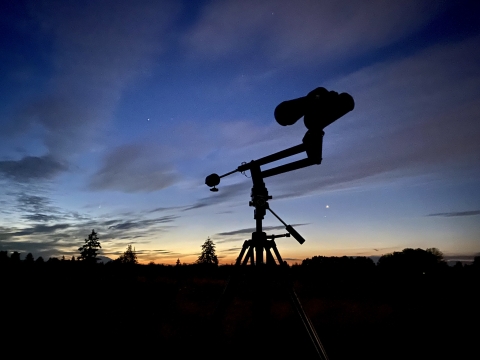Jen Johnson loves looking up.
She looks up during the day to go birding, sometimes taking vacations just to get of a glimpse of a bird she hasn’t seen yet. She looks up after the sun goes down for night birding among the stars. She loves looking up from her house just outside of Ridgefield, Washington, where she can see the Milky Way.
“There’s a sense of wonder when I see the stars and a realization that there’s a universe beyond this Earth,” Johnson said. “It’s just a little bit better perspective on life.”
Johnson is a volunteer advocate with DarkSky, a movement dedicated to reducing light pollution and promoting responsible outdoor lighting. DarkSky is active in more than 70 countries and has dozens of active chapters in the United States, including Oregon and Washington. For Johnson, protecting the night sky is not just important so she can see birds and stars; protecting the night sky is essential for helping wildlife.
Light pollution can be debilitating for wildlife and particularly for migrating birds. Many migratory birds are phototaxic, which means they’re drawn to light. Once in a big city with lit up buildings, birds have trouble finding their way out again. Interior lights can also cause birds to fly into windows and interfere with their circadian rhythms, breeding and migration cycles.
“While I do all of this on my own time,” Johnson said, “it’s still really important. It’s just really important to me.”
Johnson moved to Ridgefield five years ago and loved how dark the sky was compared to living in the city. She worked with the City of Ridgefield to help make sure new housing developments going up followed local lighting ordinances and began sharing information about DarkSky at local events.
“It was for selfish reasons at first,” Johnson laughed. “And then I saw how much of a difference I could make.”
Johnson’s efforts, along with the advocacy of other DarkSky volunteers and birding organizations, have made an impact on protecting the night sky for the health of birds and other wildlife. The Bird Alliance of Oregon promotes a “Lights Out” campaign during spring and fall migration seasons to raise awareness about the importance of responsible lighting. Earlier this year, Portland Mayor Ted Wheeler signed a proclamation designating Sept.19-Oct. 19, 2024, as “Lights Out Portland Month.” The proclamation encourages residents to turn off unnecessary exterior and interior lights from 11 p.m. until dawn during migration periods and encourages Portlanders to “extinguish unnecessary exterior lights every night of the year.”
Johnson shared DarkSky’s Five Principles of Outdoor Lighting for you to make your home safer for birds:
- Use outdoor lighting only if needed. Do you really need Christmas lights strung up on your back deck in the middle of March? Consider your needs, and weigh those against the impact on birds, wildlife and your stargazing neighbors.
- Use targeted lighting. Do you want to highlight a cool landscape feature in your yard? Or light up your porch at night for late arrivals? Think carefully about the purpose of your lights and plan accordingly. For example, Ridgefield National Wildlife Refuge aims their security lights downward, which adds light and protect birds. The refuge has also added collision film to their office windows to help prevent bird collisions.
- Turn outdoor lights to the lowest level possible. Your security lights don’t need to light up the entire neighborhood, just the area around your house. If you can’t change the type of light you have, then adding shields or glare guards can help.
- Add controlling features to your lights. How about dimmable mood lighting on your back deck for dinner parties? Or timers so that your lights only come on at certain times of day? Switches with light sensors can often be set so that lights only turn on at dusk and turn off at dawn. Johnson suggests replacing all-night security lights with motion sensor lights.
- Use warm-colored outdoor lights. Choose warm-colored LED lights over bright white halogens. They’re safer for birds, better for your electric bill and easier on the eyes.
For more information on migratory birds in your area, Birdcast is a consortium of organizations, private companies, and government agencies that has created tools so people can follow bird migration in real time. Their bird migration forecast maps predicts bird nocturnal migration, and their live bird migration maps shows live migration patterns.
Lights may be out during migration season, but the future for dark skies is looking up.
Additional information:
Light Pollution Got You Hazy: https://usfwspacificnw.medium.com/light-pollution-got-you-hazy-were-here-to-clear-the-smog-4383946546e7
Bird-Safe City: https://medium.com/usfwspacificnw/its-for-the-birds-what-it-takes-to-develop-a-bird-safe-city-ac881717a216









